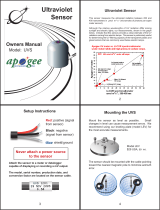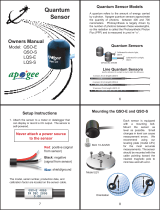
8
OPERATION
LP-80 updates and displays the current calculated τ, LAI, Fb, χ , and z values at the
bottom of the screen with each subsequent below-canopy PAR measurement.
With each above- or below-canopy measurement, a number appears to the right of the
PAR value that indicates the number of completed measurements. The displayed PAR
value refl ects the sample average. In Figure 8, the LP-80 made four above and three
below-canopy measurements, so the average of the four above-canopy PAR values is
211 μmol/(m2s), while the average of the three below-canopy values is 20 μmol/(m2s).
NOTE: When connected to the external sensor, the LP-80 uses readings from the external sensor as above-
canopy PAR readings to calculate LAI. Summary data on the bottom of the screen are recalculated using the last
above-canopy reading with each subsequent below-canopy reading.
5. Press ENTER to bring up the Save screen to save as is, annotate, or discard (Section2.3).
Press ESC to discard the values.
Both options clear the screen for new data.
2.2.3 LOG MODE MEASUREMENTS
NOTE: LAI and τ are calculated more accurately by manually sampling PAR beneath a canopy at random locations
instead of leaving the LP-80 in one place and collecting data in log mode.
1. Navigate to the Log tab.
2. Select the measurement interval by pressing the UP or DOWN arrows to select any value
between 1 and 60 min.
3. To activate the logging mode, press ENTER. The screen will begin to return data (Figure
9).
To cancel the logging mode, press ESC.
NOTE: Other tabs can be viewed while the logging mode is activated.
Figure 9 Log tab with measurements set every 1 min
The LP-80 saves data taken in this mode automatically (without annotation). While
activated, the LP-80 continues to log data until logging mode is canceled.
NOTE: This mode is for short-term experiments (1 or 2 days). The LP-80 is not designed to be left in the field for
long periods of time.
41
LP80
5. Remove and discard old batteries.
6. Insert new batteries, following the indicators on the battery holders.
NOTE: Ensure batteries or oriented properly; placing them the wrong way can damage the LP-80.
7. Press the RESET button on the top left corner of the green circuit board.
8. Rotate the cover back into position.
9. Turn the LP-80 over, with the screen facing down.
10. Replace the four washers and screws into the back cover.
4.2.2 CLEANING THE PROBE AND CONTROLLER
The probe should always be clean to ensure accurate readings. To clean the probe, use a soft
cloth and a small amount of isopropyl alcohol. Rub the surface until it is clean.
To clean the controller, use a soft cloth and water to wash off heavy dirt, then use ethyl or
isopropyl alcohol to finish cleaning.
NOTE: Only use a soft cloth when cleaning the LCD window. Tissues made from wood fiber will scratch the window.
4.3 REPAIR
METER repairs manufacturer defects and instruments within the 1-year warranty at no
charge. Repairs outside the warranty window are charged based on cost of parts, labor, and
shipping. An extra fee may be charged for rush work. METER will provide an estimated repair
cost, if requested.
All LP-80 instruments returning to METER for servicing must be accompanied with a Return
Material Authorization (RMA) number. Prior to shipping the instrument, please contact
Customer Support to obtain an RMA number.
1. Place the LP-80 in a plastic bag to avoid disfiguring marks from the packaging.
2. Do not ship any accessories.
3. Ship the LP-80 in its original case.
If the original packaging is not available, use a box that has at least 4 in of packing
material (e.g., SytrofoamTM peanuts or bubble wrap) between the instrument and each
wall of the box, ensuring the instrument is suspended in the packing material.
4. On the RMA form, please verify the ship to and bill to information, contact name, and
problem description. If anything is incorrect, please contact Customer Support.
5. Tape the box in both directions for added support.
6. Include the RMA number in the attention line on the shipping label.






















